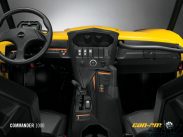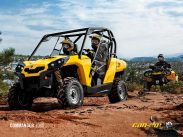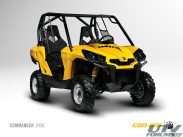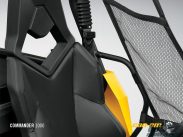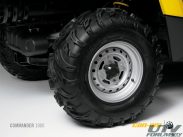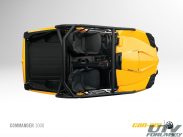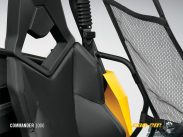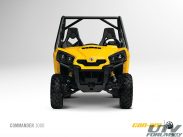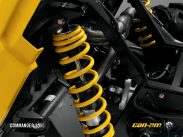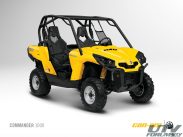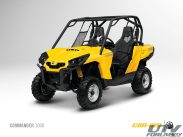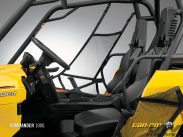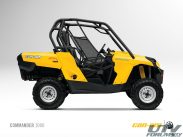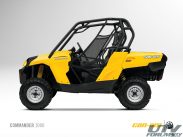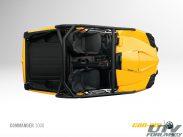Commander 1000 Features
 85-hp Rotax 1000 engine Liquid-cooled, 8-valve Rotax 976cc V-twin pumps out a class-leading 85 horsepower.
85-hp Rotax 1000 engine Liquid-cooled, 8-valve Rotax 976cc V-twin pumps out a class-leading 85 horsepower. Intelligent Throttle Control (iTC) iTC’s throttle-by-wire set up improves throttle response, smoothes power delivery and ensure precision throttle control even in the roughest of terrain.
Intelligent Throttle Control (iTC) iTC’s throttle-by-wire set up improves throttle response, smoothes power delivery and ensure precision throttle control even in the roughest of terrain. Quick-ratio steering system (10.2:1) A quicker steering ratio means more responsive handling with pinpoint accuracy and control.
Quick-ratio steering system (10.2:1) A quicker steering ratio means more responsive handling with pinpoint accuracy and control. Double A-arm front suspension with dive-control geometry The Can-Am Commander’s double A-arm front suspension is designed with dive-control geometry that works to eliminate diving under heavy breaking and rough terrain.
Double A-arm front suspension with dive-control geometry The Can-Am Commander’s double A-arm front suspension is designed with dive-control geometry that works to eliminate diving under heavy breaking and rough terrain. Torsional Trailing arm Independent (TTI) rear suspension with external sway bar Exclusive to Can-Am, TTI eliminates scrub and camber changes by using proprietary geometry that places the pivot points ahead of the rear wheels.
Torsional Trailing arm Independent (TTI) rear suspension with external sway bar Exclusive to Can-Am, TTI eliminates scrub and camber changes by using proprietary geometry that places the pivot points ahead of the rear wheels. Visco-Lok† auto-locking differential Visco-Lok automatically and progressively engages the front wheels for authentic 4×4 traction without the push of a button.
Visco-Lok† auto-locking differential Visco-Lok automatically and progressively engages the front wheels for authentic 4×4 traction without the push of a button. Large Motion Control gas bag shocks The front end, which features 10 inches of travel (25cm), has the largest diameter front, five-way preload-adjustable gas shocks in its class (36mm or 1.4 inches) for overall durability and better fade resistance.
Large Motion Control gas bag shocks The front end, which features 10 inches of travel (25cm), has the largest diameter front, five-way preload-adjustable gas shocks in its class (36mm or 1.4 inches) for overall durability and better fade resistance. Adjustable driver seat and tilt steering Automotive-type adjustments, that require no tools and offer the driver superb comfort levels.
Adjustable driver seat and tilt steering Automotive-type adjustments, that require no tools and offer the driver superb comfort levels. Industry’s exclusive Dual-level cargo box The industry’s most versatile and usable cargo box design has a 600-lb cargo capacity, dual storage levels, anti-rust box and tilt-assist dumping.
Industry’s exclusive Dual-level cargo box The industry’s most versatile and usable cargo box design has a 600-lb cargo capacity, dual storage levels, anti-rust box and tilt-assist dumping. 2-in. diameter ROPS-approved cage ROPS-approved, 2-in. steel cage that is fully approved using the Rollover Protective Structures (ROPS) industry standard.
2-in. diameter ROPS-approved cage ROPS-approved, 2-in. steel cage that is fully approved using the Rollover Protective Structures (ROPS) industry standard. 27-in. Carlisle Black Rock radial tires Purpose-built, six-ply Carlisle Black Rock radial tires mounted on 12-in. wheels provide great traction and control in a wide variety of conditions
27-in. Carlisle Black Rock radial tires Purpose-built, six-ply Carlisle Black Rock radial tires mounted on 12-in. wheels provide great traction and control in a wide variety of conditions Quick-attach side nets Located on both sides of the vehicle, side nets can be operated by one hand and won’t impair the occupants’ vision.
Quick-attach side nets Located on both sides of the vehicle, side nets can be operated by one hand and won’t impair the occupants’ vision. 240-W lighting The Can-Am Commander family of side-by-side vehicles features the industry’s best lighting system at 240 watts. Automotive-style projectors, on each side, run at 120 watts in low beam and 240 watts in high-beam mode.
240-W lighting The Can-Am Commander family of side-by-side vehicles features the industry’s best lighting system at 240 watts. Automotive-style projectors, on each side, run at 120 watts in low beam and 240 watts in high-beam mode. 650-W magneto With its 650-W Magneto, the Commander’s electrical system has up to 300 free W to power accessories.
650-W magneto With its 650-W Magneto, the Commander’s electrical system has up to 300 free W to power accessories. 10-gal gas tank The industry’s largest fuel tank lets you ride longer and work harder.
10-gal gas tank The industry’s largest fuel tank lets you ride longer and work harder. Driver and passenger advanced ergonomics The Can-Am Commander was designed with a more ergonomic seating and steering position than competitive side-by-sides.
Driver and passenger advanced ergonomics The Can-Am Commander was designed with a more ergonomic seating and steering position than competitive side-by-sides. Cockpit storage The Can-Am Commander models feature 1,928 cu in of convenient and versatile cockpit storage space so you can take your essentials with you.
Cockpit storage The Can-Am Commander models feature 1,928 cu in of convenient and versatile cockpit storage space so you can take your essentials with you. Removable free-standing seats The freestanding Commander seats can be removed from the machine without tools.
Removable free-standing seats The freestanding Commander seats can be removed from the machine without tools. Passenger handhold and grab bar The passenger handhold and grab bar provide a comfortable location for passenger’s to place their hands while riding off-road.
Passenger handhold and grab bar The passenger handhold and grab bar provide a comfortable location for passenger’s to place their hands while riding off-road. Dual cup holders Purpose-built for use off-road, twin cup holders feature integrated rubber flaps.
Dual cup holders Purpose-built for use off-road, twin cup holders feature integrated rubber flaps. D.E.S.S.™ (Digitally Encoded Security System) The industry’s first standard anti-theft device
D.E.S.S.™ (Digitally Encoded Security System) The industry’s first standard anti-theft device 11-in. of ground clearance For maximum performance in challenging terrain, the Commander has 11-in. of ground clearance.
11-in. of ground clearance For maximum performance in challenging terrain, the Commander has 11-in. of ground clearance. 214-mm disc brakes with twin-piston calipers Outboard disc brakes with 214-mm discs and twin-piston calipers.
214-mm disc brakes with twin-piston calipers Outboard disc brakes with 214-mm discs and twin-piston calipers. 1,500-lb. towing capacity Tow heavy loads of up to 1,500 lb with the Commander.
1,500-lb. towing capacity Tow heavy loads of up to 1,500 lb with the Commander. 2-in. rear hitch receiver Standard 2-in. hitch receiver accommodates a tow vehicle’s towing bar.
2-in. rear hitch receiver Standard 2-in. hitch receiver accommodates a tow vehicle’s towing bar. Fits in the bed of most full-size pickup trucks The Commander family can fit in the bed of most full-size pickup trucks.
Fits in the bed of most full-size pickup trucks The Commander family can fit in the bed of most full-size pickup trucks. Easy-to-use maintenance center Easily accessible and out of the elements under the hood, a centralized maintenance area allows access to the air box, radiator and coolant overflow. Fuses and relays are also easily accessible.
Easy-to-use maintenance center Easily accessible and out of the elements under the hood, a centralized maintenance area allows access to the air box, radiator and coolant overflow. Fuses and relays are also easily accessible.-
- Type
- 976cc, V-twin, liquid-cooled, SOHC, 8-valve (4-valve/cyl)
- Bore & Stroke
- 91 x 75 mm
- Fuel System
- iTC™ with EFI and 54mm Throttle Body, 2 Siemens∞ VDO injectors
- Starting System
- Electric
- Transmission
- CVT, sub-transmission with high, low, park, neutral & reverse. Standard engine braking
- Drive Train
- Selectable 2WD/4WD shaft driven with Visco-Lok† front differential
Engine
-
- Frame
- Steel
- Cage type
- 2-inch diameter, high-strength steel, ROPS-approved
- Steering wheel adjustment
- Adjustable tilt steering
- Front Suspension Type/Shocks
- Double A-arm with dive-control geometry / Motion Control shocks
- Front Suspension Travel
- 10 in (254 mm)
- Rear Suspension Type/Shocks
- Torsional Trailing arm Independent (TTI) with external sway bar/ Motion Control shocks
- Rear Suspension Travel
- 10 in (254 mm)
- Front Brakes
- Dual 214 mm ventilated disc brakes with hydraulic twin-piston calipers
- Rear Brake
- Single 214 mm ventilated disc brake with hydraulic twin-piston caliper
- Tires/Front
- Carlisle∞ Black Rock27 x 9 x 12 in686 x 229 x 305 mm
- Tires/Rear
- Carlisle∞ Black Rock27 x 9 x 12 in686 x 229 x 305 mm
- Wheels
- Steel
Chassis
-
- L x W x H (in)
- 118.3 x 58.6 x 72 in
- L x W x H (mm)
- 3,004 x 1,489 x 1,829 mm
- Wheelbase
- 75.8 in (1,924 mm)
- Ground Clearance
- 11 in (279 mm)
- Dry Weight
- 1,295 lb (585 kg)
- Towing Capacity
- 1,500 lb (680 kg)
- Cargo Box Capacity
- Total: 600 lb (272 kg)Upper: 400 lb (181 kg)Lower: 200 lb (91 kg)
- Cockpit Storage
- Glove Box: 4.5 gal (17.2 L)Under driver seat: 3,5 gal (13,1 L)
- Fuel Capacity
- 10 US gal (37.8 L)
Dimensions
-
- Instrumentation
- Multi-function gauge: Speedometer, tachometer, odometer, trip and hour meters, fuel, gear position, sport mode, seat belt and 4×4 indicator, diagnostics, clock, auto shut off
- Anti-Theft
- D.E.S.S.™ (Digitally Encoded Security System)
- Electrical
- Prewired for winch
- Lighting
- 4 60-watt projectors with tail lights/brake light
- DC Outlet
- Lighter type in console, standard connector in the back (15A)
- Color(s) available
- Yellow
- MSRP
- $12,999
Features
-
- Basic
- 6 months limited factory warranty
- Extended
- B.E.S.T. available from 6 to 18 months
Warranty
-
- Rotax 1000 EFI engine, 85 hp.
- Best fuel efficiency in the industry
- Double A-arm front suspension with dive-control geometry
- Torsional Trailing arm Independent (TTI) rear suspension with external sway bar
- Visco-Lok† auto-locking front differential
- Industry-exclusive Dual-level™ cargo box
- Rotax 1000 EFI engine, 85 hp.
Package
2011 Can-Am Commander 1000 XT Review
Timing is everything. Just a few months ago, Can-Am announced that, with its then-new Commanders 800 and 1000, it had the fastest, most powerful UTVs on the planet. In its videos the Canadian manufacturer drove home this claim with drag races and sled (weight) pulls, showing both its 1000 and 800 side-by-sides destroying all contenders, including the previously fastest, pure-performance Polaris RZR 800.
 The Can-Am Commander 1000 XT lives up to its claims of great handling and power while offering unique features.
The Can-Am Commander 1000 XT lives up to its claims of great handling and power while offering unique features.Those videos are still on Can-Am’s website, but, with the more recent advent of Polaris’ new pure-performance, lightning-fast and great-handling RZR XP 900, now they may be old news, at least according to Polaris, our preliminary tests, and unsanctioned drag races.
Bad timing on Can-Am’s part? Probably. Has Can-Am hung its head in shame? Nope. While the RZRs are pure-performance UTVs, (only minimal cargo room and much lighter overall weight), the Commanders are marketed as sport/utility machines. And in that category, they’re probably still on top for performance.
For a couple years, Can-Am had been dropping hints about its upcoming side-by-side, and the machine does indeed live up to most of its claims. It’s got a very strong motor, handles great and has several thoughtful – and some unique – features.
Between the 800 and 1000, there are five models. The 1000 comes in three versions: base model ($12,799) with X package ($14,699) or XT package ($14,299). The 800 comes in only the base model ($11,699) and XT ($13,199). With the X package you get a major shock upgrade, sway bar, beefier tires, black/yellow bodywork, and other cosmetic goodies. The XT goes with the stock shocks, but adds to the X package mudguards, two different wheel upgrade choices, bodywork color choice of red, yellow, or camo, and a winch (your off-road pals will be happy to have you along on any ride where some camping gear needs schlepping or, for that matter, when they feel there’s a good chance of getting hopelessly stuck).
 We spent hours on a Commander 1000 XT and we had a blast. Of the three areas at the Oregon Dunes, Winchester Bay (here) has the most varied and challenging terrain.
We spent hours on a Commander 1000 XT and we had a blast. Of the three areas at the Oregon Dunes, Winchester Bay (here) has the most varied and challenging terrain.On a sunny, warm afternoon at the Oregon Dunes, we scored from DuneGuide a 1000 XT set up with ATV sand tires, and ripped up the dunes for several hours. Powering all the 1000s is an identical 976cc, V-Twin, liquid-cooled, SOHC, 8-valve, four-stroke with EFI. The 800 has the same motor with a 13.5mm shorter stroke, hinting at less torque. That’s the only significant design difference between the 800 and 1000.
Can-Am claims 85 horses for the 1000, compared to Polaris’ claim of 85-90 for its 900, and that machine is 300 pounds lighter than the Can-Am. If you can believe the speedo readings – Polaris says theirs exactly matches a GPS – the Polaris top out around 75 mph, and the Can-Am 70 mph.
A UTV is a machine the owner is likely to take to some pretty remote places and on longer trips, and the Can-Am gets 18.6 mpg, the best of any UTV according to manufacturer claims. Unique to Can-Am, every Commander comes with three different ignition keys, each allowing a different level of performance – a feature that can take some of the pressure off when letting someone else drive your machine.
The V-Twin 1000 produces a healthy rumble at idle and, screaming, still meets the strictest decibel requirements, like at the Oregon Dunes. At the Winchester Bay area the 1000 rockets up the steepest and longest hills (which are a little steeper than Oldsmobile at Glamis, for example), and revs out very hard. Can-Am’s quads, also powered by Austrian Rotax motors, pack a punch, and its UTVs are no different. Another unique feature on the Commander is Can-Am’s Intelligent Throttle Control System. When the driver smacks whoops or other really rough terrain, the right foot can tend to bounce on and off the throttle. The ITC senses this and smoothes out the input to the fuel injectors. Pretty slick.
 Like all Can-Am products we’ve tested, fit and finish on the Commanders is excellent.
Like all Can-Am products we’ve tested, fit and finish on the Commanders is excellent.As with most UTVs, these Commanders come with a CVT (continuously variable, belt-drive transmission). The adjustment weights in Can-Am’s CVT are set up for a strong, rather than sedate launch. Many CVTs have built-in automatic engine compression braking and the Can-Am’s is set up for a less-dramatic effect and therefore more aggressive driving. A right-hand lever controls the drive positions: high, low, neutral and park. The Can-Am has selectable 2WD or 4WD. Be ready to get a workout in 4WD, though, because there the steering gets pretty stiff. Two-wheel-drive isn’t so bad, but we’d sure enjoy power steering, which will eventually makes its way onto every UTV, as is the trend with 4WD quads.
The Can-Am is fast, but it’s also a very capable workhorse. The cargo area in back, which Can-Am says it’s the biggest in the industry, will carry 600 pounds and is designed with two levels, the bottom of which is watertight. Tow rating is 1500 pounds. Note that these limits are typically set by corporate lawyers and are based more on braking power and stability concerns. Actual pulling power is probably higher. Unique to the Can-Ams, no tools are required to adjust the driver’s seat. And, Can-Am takes it a step further by allowing, via collapsible legs, both seats to be used outside the vehicle. The no-tools steering wheel can be tilted up to 30 degrees, making entry and exit a little easier. Clearly, Can-Am put a lot of thought into these machines.
 The four, 60W stock lights provide very good illumination. For this dune test, up front we ran ITP Mud Lite tires, 28×10-12. All four of the stockers are Carlisle Black Rock 27×9-12 and are said to work well.
The four, 60W stock lights provide very good illumination. For this dune test, up front we ran ITP Mud Lite tires, 28×10-12. All four of the stockers are Carlisle Black Rock 27×9-12 and are said to work well.Because of the extra weight, these UTVs don’t feel quite as nimble as the RZRs, but they’re still a cut above any of the other UTVs for handling. Some UTVs will tend to push (or wash out) in turns, but the Commanders carve a precise turn. Even with the higher-traction sand tires, it’s still possible to pull off powerslides in the sand and, as demonstrated in Can-Am’s own videos, also on hardpack.
Can-Am claims a close steering ratio (steering rotation lock to lock), but for aggressive driving, we’d like it tighter still. On a bike or quad, it doesn’t take much input to quickly countersteer in a turn to correct for a powerslide. But on UTVs, it’s hard to crank the steering wheel back-and-forth quickly enough. And, on a UTV without power steering, you don’t want to get a thumb or finger inside the spokes of the steering wheel. In reverse and at even a crawl, a rut can catch a tire and whip the steering wheel at the speed of light. The aftermarket does offer power steering kits and close-ratio steering boxes for UTVs.
But you don’t have to go to the aftermarket to get the Fox Racing HPG piggyback, fully adjustable (dual-speed compression, rebound and preload) shocks that come with the X package. Compared to the stock shocks (not piggyback, adjustable for only preload) the Fox suspension offers noticeably better performance, according to reports. They allow the 1300-pound beast to actually skip over sand whoops without too much fanfare. But even the stock shocks do a good job of smoothing out landings, even sideways landings, from four- or five-foot high jumps, and allow the base model and XT to stay flat in aggressive turns. Yet, they still offer a reasonably plush ride. The bucket seats also provide a comfortable ride while providing plenty of support.
UTVs have been around for several years and the early units were decidedly non-sporty. They could carry all kinds of stuff, but very slowly. Yamaha’s Rhino, which can also work hard, raised the bar a little by adding some performance to the equation, and that machine quickly became Yamaha’s best-selling ATV – including all its quads.
 Instead of conventional A-arms in back, Can-Am uses what it calls a Torsional Trailing Arm on the Commanders, as well as on its big four-bys.
Instead of conventional A-arms in back, Can-Am uses what it calls a Torsional Trailing Arm on the Commanders, as well as on its big four-bys.Now, with its Commander side-by-sides, Can-Am has raised the bar quite a bit higher. They’ve demonstrated that a sport/utility UTV can offer a high-enough level of performance to satisfy even a really aggressive driver, while at the same time carrying a surprising amount of whatever.

